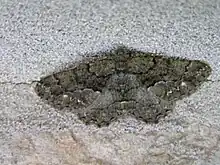Peribatodes ilicaria
Peribatodes ilicaria, the Lydd beauty, is a moth of the family Geometridae. The species was first described by Carl Geyer in 1833. It can be found in Europe and North Africa.
| Peribatodes ilicaria | |
|---|---|
 | |
| Scientific classification | |
| Domain: | Eukaryota |
| Kingdom: | Animalia |
| Phylum: | Arthropoda |
| Class: | Insecta |
| Order: | Lepidoptera |
| Family: | Geometridae |
| Genus: | Peribatodes |
| Species: | P. ilicaria |
| Binomial name | |
| Peribatodes ilicaria (Geyer, 1833) | |
| Synonyms | |
| |
The wingspan is about 30 mm. Peribatodes ilicaria is difficult to certainly distinguish from its congeners. See Townsend et al.[1]
- Peribatodes rhomboidaria ([Denis & Schiffermüller], 1775)
- Peribatodes secundaria ([Denis & Schiffermüller], 1775)
- Deileptenia ribeata (Clerck, 1759)
- Alcis repandata (Linnaeus, 1758)
All are grey brown with a darker cross band and lines variously developed.
The moths fly from July to September depending on the location.
The larvae feed on various trees and shrubs.
References
- Martin C. Townsend, Jon Clifton and Brian Goodey (2010). British and Irish Moths: An Illustrated Guide to Selected Difficult Species. (covering the use of genitalia characters and other features) Butterfly Conservation.
This article is issued from Wikipedia. The text is licensed under Creative Commons - Attribution - Sharealike. Additional terms may apply for the media files.